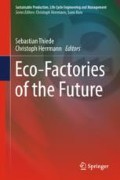Abstract
The increase in energy efficiency in manufacturing and in particular in the area of compressed air is becoming a top issue in the context of factory planning and operation. Facing this development, the European Commission entrusted the Seventh Framework Program, Horizon 2020, to strengthen the research efforts to hit the proclaimed environmental, energetic and economic objectives of the European Union. In this paper, the authors present selected results on how to re-engineer brownfield factories to become clean and competitive factories of the future. Furthermore, the focus is put on energy-efficient generation, preparation, distribution and utilization of compressed air. It provides a systematic and practical approach to re-engineer existing compressed air systems to become eco-efficient. In European industries, around 10% of the final energy utilized is converted into compressed air as a factory internal energy source and hence plays a vital role for various applications such as handling and assembly of parts. When generating compressed air, it is important to use efficient compressor stations with optimized compressed air preparation and appropriately designed compressed air systems for distributing and utilizing the compressed air. However, due to a lack of transparency and knowledge in terms of actual demands and technical dependencies, compressed air systems are often operated inefficiently. The holistic approach described in this article suggests specific improvement strategies and innovative technology solutions based on profound evaluations in industrial cases.
Access this chapter
Tax calculation will be finalised at checkout
Purchases are for personal use only
Notes
- 1.
Pressure drops will only influence the energy efficiency of a compressed air system negatively if they occur between the centralized storage and the valve at the pneumatic cylinder that means within the piping part that is constantly ventilated with compressed air. The pressure drops have to be compensated by an increased pressure level at the generation unit in order to guarantee a minimum supply pressure at the application. This results in higher costs for air generation. The pressure drops within tubing between valve and actuator are similar to resistances and influence the dynamic behaviour significantly.
- 2.
The improvement strategies are result of the research project EnEffAH (Hirzel and Köpschall 2012). The abbreviation “app.” defines the degree of applicability of the shown improvement method; “pot.” shows the possible saving potentials. Both values are rough approximations.
References
Bundesministerium für Umwelt, Naturschutz und Reaktorsicherheit (2012) Energiemanagementsysteme in der Praxis - ISO 50001: Leitfaden für Unternehmen und Organisationen
DIN (2010) Energieeffizienz-Dienstleistungen – Definitionen und Anforderungen; Deutsche Fassung EN 15900:2010
Eurostat (2009). http://ec.europa.eu/eurostat/help/new-eurostat-website
Gloor R (2000) Energieeinsparungen bei Druckluftanlagen in der Schweiz
Hirzel S, Köpschall M (2012) Energieeffizienz in der Produktion im Bereich Antriebs- und Handhabungstechnik, Project booklet. http://www.eneffah.de
IEA (2009) International Energy Agency (IEA). http://www.iea.org/
Müller E, Engelmann J, Löffler T, Strauch J (2009) Energieeffiziente Fabriken planen und betreiben, Springer. http://link.springer.com/book/10.1007/978-3-540-89644-9, p 288
Posselt G (2015) Towards energy transparent factories. Springer International Publishing. ISBN 978-3-329-20868-8
Posselt G, Linzbach J, Weinert N, Kaluza A, Slupek K, Bernas M, Palasciano C, Eytan A (2013) the eco-factory solutions for experts and decision makers project booklet. http://www.emc2-factory.eu
Radgen P, Blaustein E (2001) Compressed air systems in the European Union. ISBN 3.932298-16-0
VDMA (2014) VDMA-Einheitsblatt Nr. 66412-10, Manufacturing Execution Systems—Daten für Fertigungskennzahlen. http://www.vdma.org/documents/105628/2244593/Entwurf+VDMA+66412-10
Acknowledgements
The research leading to the presented results has received funding from the European Community’s Seventh Framework Program (FP7/2007-2013) under the grant agreement no. 285363 with the title “Eco Manufactured Transportation Means from Clean and Competitive Factory” (Posselt et al. 2013). For further information about the project, visit www.emc2-factory.eu.
Author information
Authors and Affiliations
Editor information
Editors and Affiliations
Rights and permissions
Copyright information
© 2019 Springer Nature Switzerland AG
About this chapter
Cite this chapter
Pastewski, N., Krichel, S., Posselt, G., Linzbach, J., Plank, M. (2019). Approach for Achieving Transparency in the Use of Compressed Air in Manufacturing as a Basis for Systematic Energy Saving. In: Thiede, S., Herrmann, C. (eds) Eco-Factories of the Future. Sustainable Production, Life Cycle Engineering and Management. Springer, Cham. https://doi.org/10.1007/978-3-319-93730-4_9
Download citation
DOI: https://doi.org/10.1007/978-3-319-93730-4_9
Published:
Publisher Name: Springer, Cham
Print ISBN: 978-3-319-93729-8
Online ISBN: 978-3-319-93730-4
eBook Packages: EngineeringEngineering (R0)

